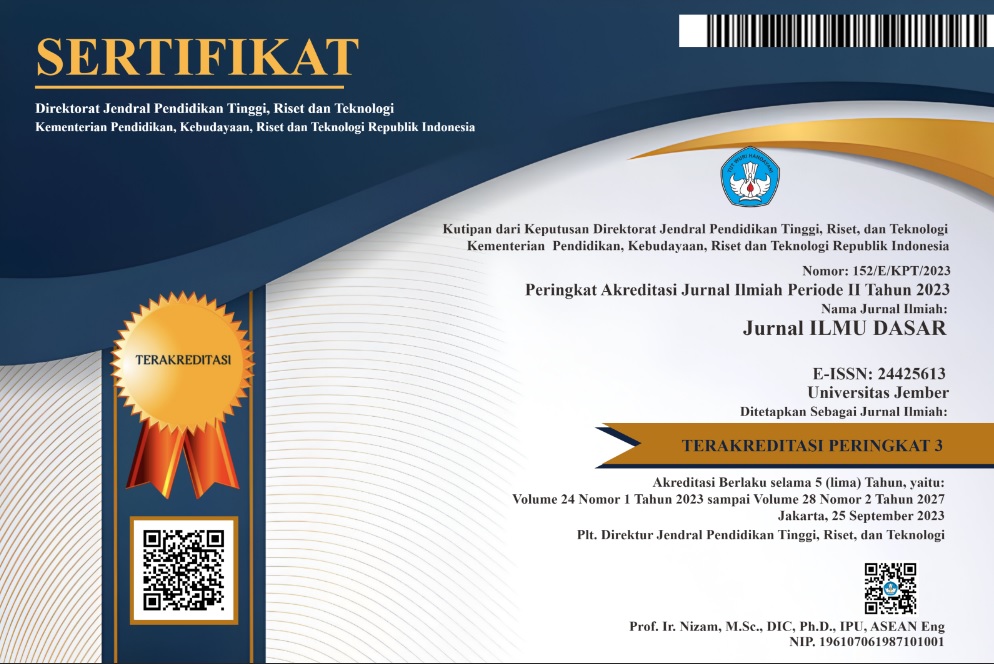Analysis of SIR Mathematical Model for Malaria Disease: A Study in Assam, India
DOI:
https://doi.org/10.19184/jid.v24i2.38917Keywords:
Mathematical biology, epidemiology, mathematical model, SIR modelAbstract
The global outbreak of covid-19 pandemic is still affecting people around the globe very badly. Before the covid-19 pandemic outbreak, several research works were done for the detection and prevention of various infectious diseases using different mathematical modeling. Implementing mathematical modeling to resolve problems in Biology and physiology is generally called Mathematical Biology, an extremely interdisciplinary area. The applications of mathematical modeling in the analysis of infectious diseases help to concentrate on the necessary processes associated with forming the infectious disease epidemiology and specifications estimation. The compartmental mathematical model can be either SI, SIS, SIR, SIRS, or SEIR where S, I, R, and E denote susceptible, infected, recovered, and exposed respectively. Malaria is an infectious disease that has a large economic and health impact on society. This study aims to predict the estimation of suspected, infected and recovered people using the SIR mathematical model of the Barama area of Baksa District in Assam, India. Here we analyzed the Basic Reproductive Ratio of the SIR model for malaria disease and examined if malaria is epidemic or endemic in that area.
Downloads
References
Affandi, Pardi & Faisal. 2018. Optimal Control Mathematical SIR Model of Malaria Spread in South Kalimantan. Journal of Physics: Conf. Ser. 1116(2): 1-17.
Daughton A. et al. 2017.An approach to and web-based tool for infectious disease outbreak intervention analysis. Sci Rep. 7: 46076.
Devi R & Choudhury BKD. 2018. SIR Model-based Study on Chicken Pox Outbreak in Kamrup (M) District of Assam, India. International Journal of Computer Applications. 182(20): 1-4.
Devi R & Choudhury BKD. 2020. Mathematical Modelling of Infectious Diseases with Special reference to Malaria Disease. Journal of the Social Sciences. 48(3): 2408-2417.
Imane BEL et al. 2014. Stochastic Study for SIR Model. Applied Mathematical Sciences. 8: 405-413.
Jonshon T. 2009. Mathematical Modeling of Diseases: Susceptible-Infected-Recovered (SIR) Model. University of Minnesota, Morris. http://www.morris.umn.edu/academic/math/Ma4901/Sp09/Final/TeriJohnson-Final.pdf.
Karsai J. et al. 2020. Modeling the transmission dynamics of varicella in Hungary. Journal of Mathematics in Industry. 10: 12.
Kretzschmar M & Wallinga J. 2009. Modern Infectious Disease Epidemiology. New York: Springer.
Pandiyan M & Sindhu DS. 2022. Fuzzy SIR-Epidemic Model for Transmission of Malaria. ECS Transactions. 107: 7691
Schneeweiss S. 2006. Sensitivity Analysis and External Adjustment for Unmeasured Confounders in Epidemiologic Database Studies of Therapeutics. Pharmacoepidemiology and Drug Safety. 15(5): 291-303.
Singh S. et al. 2005. Modelling and Analysis of The Spread of Malaria: Environmental and Ecological Effects. Journal of Biological Systems. 13(01): 1-12.
Smith NR. et al. 2018. Agent-based Models of Malaria Transmission: A Systematic Review. Malaria Journal. 17(1): 299.
Sweileh WM. 2022. Global Research Activity on Mathematical Modeling of Transmission And Control of 23 Selected Infectious Disease Outbreak. Globalization and Health. 18(4).
Venkatachalam S & Mikler AR. 2006. Modeling infectious diseases using global stochastic field simulation. 2006 IEEE International Conference on Granular Computing. Atlanta: IEEE.
Wedajo AJ. et. al. 2018. Analysis of SIR Mathematical Model for Malaria Disease With The Inclusion of Infected Immigrants. IOSR Journal of Mathematics. 14: 10-21.
Kumar D. et al. 2019. A New Fractional SIRS-SI Malaria Disease Model With Application of Vaccines, Antimalarial Drugs, and Spraying. Adv Differ Equ. 278(2019).
Badshah N & Akbar H. 2021. Stability Analysis of Fractional Order SEIR Model for Malaria Disease in Khyber Pakhtunkhwa. Demonstratio Mathematica. 54(1): 326-334.
Oke IS. et al. 2020. Mathematical Modeling of Malaria Disease with Control Strategy.Commun. Math. Biol. Neurosci. 2020: 43.
Ibrahim MM. et al. 2020. Impact of Awareness to Control Malaria Disease: A Mathematical Modeling Approach. Complexity. 2020: 8657410.








